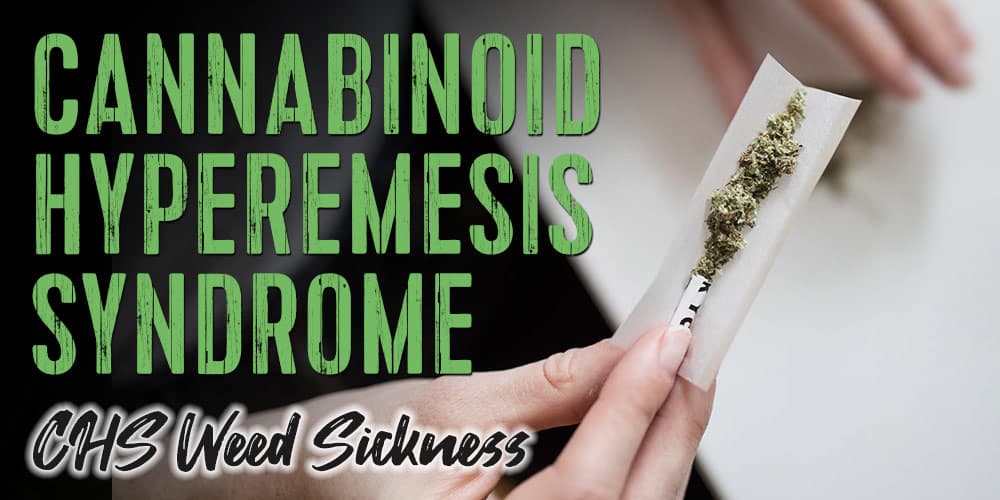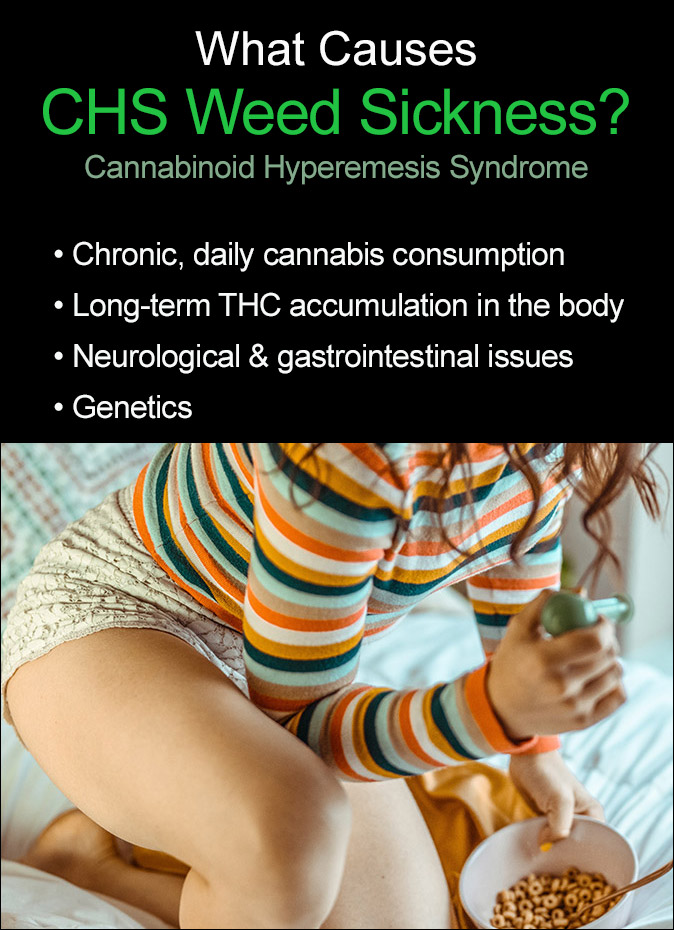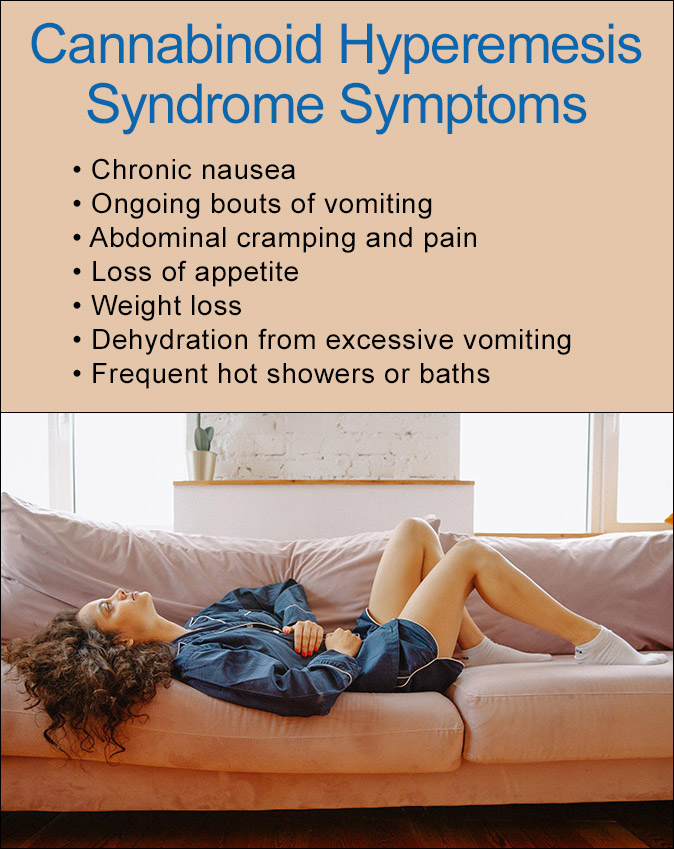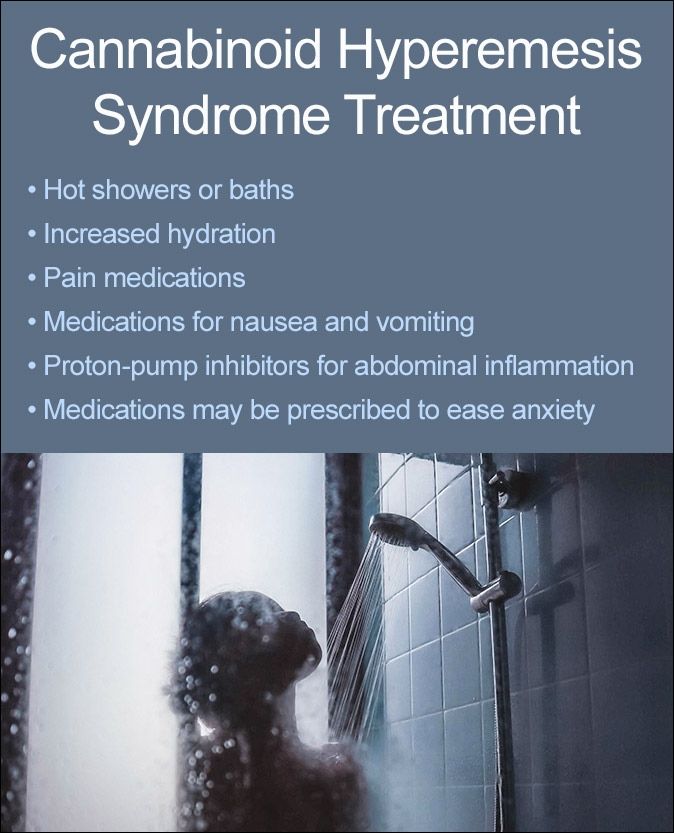
People who frequently smoke weed and long-time users of marijuana who encounter abdominal pain, nausea, and vomiting might be experiencing Cannabinoid Hyperemesis Syndrome, sometimes referred to as CHS weed sickness.
While cannabis is considered a harmless drug by many people, there are known negative side effects of marijuana that can cause problems for some individuals.
Increasingly potent strains of cannabis and various forms of dab wax concentrates can lead to a heightened tolerance, dependence, and addiction.
The National Institutes of Health (NIH) estimates that 30 percent of individuals who use weed regularly may have some degree of marijuana use disorder.
What is Cannabinoid Hyperemesis Syndrome or CHS Weed Sickness?
Cannabinoid Hyperemesis Syndrome is an abdominal issue that causes some marijuana users to feel ill, with symptoms of nausea, vomiting, and stomach cramps.
It is sometimes called cannabis hyperemesis syndrome, and it usually only affects long-term, frequent cannabis users although it can also appear for others who are intermittent users, especially from high doses of THC.
Greening out from smoking too much weed and serotonin syndrome can also cause nausea, although they are both entirely different conditions.
Many users believe CHS symptoms can be treated by ingesting more weed, which unfortunately continues the cycle of symptoms.
The condition may be serious enough that a person needs hospitalization, especially if other health complications arise from CHS weed sickness.
Along with THC that causes the “high” users experience, cannabis has other active ingredients that bind to molecules in the brain and body.
The endocannabinoid system is quite complex and extends throughout the entire body to regulate or control memory, eating, metabolism, anxiety, and a host of many other functions.
This is why combining antidepressants like Lexapro and weed or stimulants such as Adderall and weed can create other physical or mental health issues.
Through the endocannabinoid system, ingredients in marijuana bind to molecules in the digestive tract and can alter the time it takes to fully process food.
Cannabis also affects the band of muscles that control the esophagus, which is the organ that allows food into the stomach.
It is very possible that long-term marijuana use can change the way these bodily processes normally work.
Even if a person doesn’t think they use a lot of marijuana compared to other people, only using it once a day can still cause cannabinoid hyperemesis syndrome or weed sickness.
Cannabinoid Hyperemesis Syndrome is Increasing
Until recent years, Cannabinoid Hyperemesis Syndrome was a relatively rare condition.
With the legalization of marijuana in many states, CHS weed sickness is becoming more common because an increasing number of people are regularly using cannabis.
Some people are also using marijuana more frequently or strains with a higher potency than they did before legalization.
Marijuana is the most used drug in the United States, according to the National Center for Drug Abuse Statistics and long-term marijuana users are at a higher risk of experiencing CHS weed sickness than others.
Data from the JAMA Network shows emergency room cases for CHS sickness doubled in the United States and Canada between 2017 and 2021.
Cannabinoid hyperemesis syndrome can lead to severe and prolonged bouts of nausea, vomiting, and abdominal pain.

Causes of CHS Weed Sickness
Because cannabis is still considered a schedule I substance by the federal government, there has been very little research into the long-term effects it has on the body.
According to current evidence, CHS is thought to be caused by:
- Chronic, daily cannabis consumption
- Long-term THC accumulation in the body
- Neurological and gastrointestinal issues
- Possible link to genetics
Even though researchers are still working to identify the exact cause of cannabinoid hyperemesis syndrome, it is known that cannabis acts differently in the brain than in the digestive tract.
In the brain, marijuana often helps prevent nausea and vomiting, which is why people undergoing chemotherapy or other issues that cause similar symptoms sometimes benefit from using the drug.
In the digestive tract, though, marijuana can have the opposite effect. At first, brain signals that ease nausea and vomiting are likely to override any digestive tract problems.
Heavy or long-term cannabis use combined with an increased tolerance or dependence can change that.
When certain receptors in the brain are altered from prolonged marijuana consumption, researchers believe signals in the digestive tract can take over and lead to stomach pain, nausea, and severe bouts of vomiting.
CHS weed sickness symptoms will usually remain if a person continues to use marijuana.

Cannabinoid Hyperemesis Syndrome Symptoms
The first noticeable symptom of cannabinoid hyperemesis syndrome is known as the prodromal phase of CHS weed sickness, which results in early morning nausea, stomach pain, and possibly vomiting.
In the prodromal phase, symptoms may abate for a time, and a person is able to keep a normal eating pattern. It’s quite common for people to continue using marijuana because the condition hasn’t been diagnosed and they think it will help ease their symptoms.
The prodromal phase can last for months and, in some cases, years.
The next phase is referred to as the hyperemetic phase, where the condition becomes more serious.
The hyperemetic phase of cannabinoid hyperemesis syndrome can lead to some of the following symptoms:
- Chronic nausea
- Ongoing bouts of vomiting
- Abdominal cramping and pain
- Loss of appetite
- Weight loss
- Dehydration from excessive vomiting
- Frequently taking hot showers or baths
Though it may sound odd, it’s common for people with CHS weed sickness to take a lot of hot showers.
Hot showers can help reduce the symptoms of nausea and vomiting because of the way heat affects the hypothalamus, which regulates body temperature and vomiting.
The hyperemetic phase may last until a person stops using marijuana.
It’s ironic that many people wake up to an early morning smoke and then take a shower as they start their day. They associate smoking weed with helping to relieve the nausea yet fail to recognize that the warm shower is what made them feel better and not the weed.
Users with CHS weed sickness continue using because they think it helps them feel better and never realize that marijuana is making them sick.
Left untreated, other serious health complications can arise from this phase of cannabinoid hyperemesis syndrome, such as muscle spasms and weakness, heart rhythm abnormalities, kidney failure, seizures, shock, and brain swelling in severe cases.
In the recovery phase, CHS weed sickness symptoms go away and a person regains a normal, healthy appetite, but symptoms tend to immediately reappear if a person returns to marijuana use.
Cannabinoid Hyperemesis Syndrome Treatment
Cannabinoid hyperemesis syndrome treatment varies depending on the progression of the condition.
In the early prodromal phase, simply avoiding marijuana use will make the symptoms subside and go away completely if an individual remains abstinent.
In the later stages of the hyperemetic phase, hospitalization may be required because dehydration can be dangerous if not monitored and treated.
While giving up marijuana may be easy for some people, others with a psychological addiction may deny that weed is the problem and suffer from an undiagnosed cannabis use disorder.
For people with a marijuana dependence or addiction, rehab treatment is very effective.
With even a relatively short period of sobriety and counseling approaches like Cognitive Behavioral Therapy (CBT) and Dialectical Behavior Therapy (DBT), people who undergo treatment will rebalance the brain’s chemistry.
This allows the body to return to normal functioning, while learning how to adjust their behavior and perspective in a healthy way.

The best treatment for cannabinoid hyperemesis syndrome includes:
- Hot showers or baths
- Pain medications
- Medications to reduce nausea and vomiting
- Increased hydration or intravenous fluids for dehydration
- Proton-pump inhibitors to treat abdominal inflammation
- Benzodiazepines or sedatives may be prescribed to help ease anxiety
It’s important to see a doctor if severe vomiting has continued for more than a day and to be completely honest about the duration and amount of marijuana the person has been using.
It can be difficult for some people to accept that marijuana is causing weed sickness due to cannabinoid hyperemesis syndrome. Getting past the denial is the fastest way to recovery.
Frequently Asked Questions
How common is cannabinoid hyperemesis syndrome?
Cannabinoid hyperemesis syndrome is fairly rare, but the number of cases is increasing, especially in states that have legalized marijuana.
JAMA estimates that 2.75 million people in the United States will develop CHS each year based on surveys and emergency room visits, although that number is probably underreported.
Long term daily users and those with cannabis use disorder are at the highest risk, and it is most common among males between the ages of 18 and 39 years old.
How long does cannabinoid hyperemesis syndrome last?
Severe symptoms of nausea, vomiting, cramps, and abdominal pain occur during the hyperemetic phase and generally last for one or two days, although some symptoms may continue for a week or more.
All symptoms usually fade away within a week to 10 days after a person completely stops using marijuana.
Each person is different, and the severity and duration of symptoms will depend on how long and how often a person uses cannabis, as well as the potency.
After recovery, the symptoms can reappear if a person begins using marijuana again.
What is the best treatment for CHS weed sickness?
Stopping all use of marijuana is the best treatment for CHS and the only way to ensure lasting relief of symptoms.
If vomiting continues for more than a day, it’s important to drink plenty of water and fluids with electrolytes such as Gatorade or Pedialyte to avoid dehydration.
Hot showers or baths can be effective for providing temporary relief of many symptoms.
Why do hot showers help cannabis hyperemesis syndrome?
Researchers are unsure why hot showers and baths relieve CHS, but it is known that they do help reduce the symptoms.
Hot showers are not a cure, and they only provide temporary relief. The symptoms will often return after ending the shower or bath.
The heat is thought to interact with the body’s endocannabinoid receptors or hypothalamus to provide relief. It’s also possible the heat dilates blood vessels to temporarily reduce cramps and pain in the abdomen.
How do I know if I have CHS?
The symptoms of cannabinoid hyperemesis syndrome overlap with the flu and many other gastrointestinal issues, so diagnosing it can tricky.
Nausea, vomiting, cramps, abdominal pain, and loss of appetite are symptomatic of a wide range of conditions.
Key distinguishing signs of CHS include:
- Heavy, long-term marijuana use
- Daily cannabis consumption
- Hot showers or baths provide temporary relief
- Symptoms disappear within a few days after discontinuing cannabis use
- Using marijuana again causes a rebound of symptoms
Can you smoke light quantities of weed with CHS?
No, it is not recommended to use any type of cannabis products (smoking or edibles) for anyone who has experienced CHS weed sickness.
The symptoms are caused by THC and cannabis use, and even small amounts can lead to a return of nausea, vomiting, and other issues.
Can CBD oil cause cannabinoid hyperemesis syndrome?
Most research suggests the THC in cannabis is responsible for causing the symptoms of cannabinoid hyperemesis syndrome, and not CBD.
Pure CBD should not cause CHS symptoms to appear, except in extremely rare circumstances or very high doses. However, it’s important to note that many CBD products also contain small amounts of THC.
For anyone who has experienced CHS and is considering the use of CBD, it’s crucial to carefully read the packaging to make sure the product does not contain any amount of THC.
Related Posts
- Lexapro and Weed – Can I Mix Marijuana and Antidepressants?
It’s no secret that people use marijuana to cope with stress or depression, but unlike…
- Fetal Alcohol Syndrome - What is It and What are the Symptoms?
Did you know that Fetal Alcohol Syndrome (FAS) is the leading cause of preventable birth…
- Dry Drunk Syndrome and What is a Dry Drunk?
The term Dry Drunk Syndrome, or simply Dry Drunk, refers to a person who quit…
